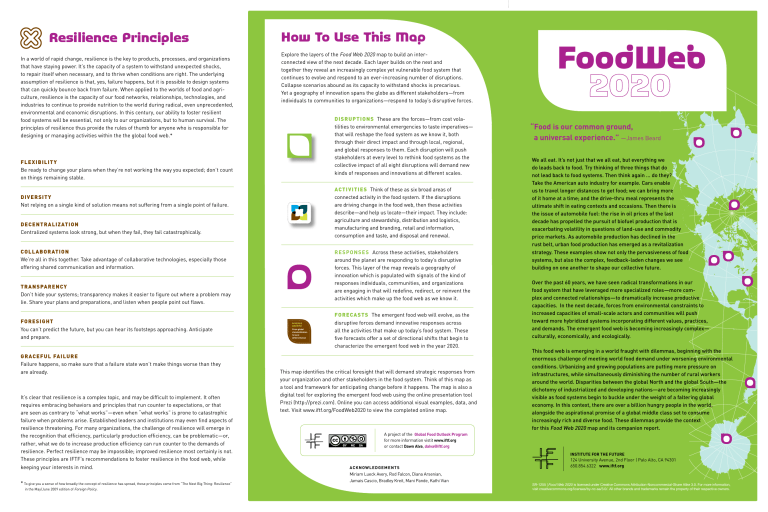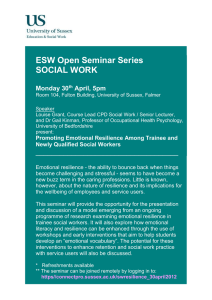
Resilience Principles In a world of rapid change, resilience is the key to products, processes, and organizations that have staying power. It’s the capacity of a system to withstand unexpected shocks, to repair itself when necessary, and to thrive when conditions are right. The underlying assumption of resilience is that, yes, failure happens, but it is possible to design systems that can quickly bounce back from failure. When applied to the worlds of food and agri‑ culture, resilience is the capacity of our food networks, relationships, technologies, and industries to continue to provide nutrition to the world during radical, even unprecedented, environmental and economic disruptions. In this century, our ability to foster resilient food systems will be essential, not only to our organizations, but to human survival. The principles of resilience thus provide the rules of thumb for anyone who is responsible for designing or managing activities within the the global food web.* How To Use This Map Explore the layers of the Food Web 2020 map to build an inter­­­‑ connected view of the next decade. Each layer builds on the next and together they reveal an increasingly complex yet vulnerable food system that continues to evolve and respond to an ever-increasing number of disruptions. Collapse scenarios abound as its capacity to withstand shocks is precarious. Yet a geography of innovation spans the globe as different stakeholders—from individuals to communities to organizations—respond to today’s disruptive forces. Disruptio ns These are the forces—from cost volatilities to environmental emergencies to taste imperatives— that will reshape the food system as we know it, both through their direct impact and through local, regional, and global responses to them. Each disruption will push stakeholders at every level to rethink food systems as the collective impact of all eight disruptions will demand new kinds of responses and innovations at different scales. Fl exibi l ity Be ready to change your plans when they’re not working the way you expected; don’t count on things remaining stable. Activities Think of these as six broad areas of connected activity in the food system. If the disruptions are driving change in the food web, then these activities describe—and help us locate—their impact. They include: agriculture and stewardship, distribution and logistics, manufacturing and branding, retail and information, consumption and taste, and disposal and renewal. Diversit y Not relying on a single kind of solution means not suffering from a single point of failure. Decentra l i z ati on Centralized systems look strong, but when they fail, they fail catastrophically. Colla b or atio n We’re all in this together. Take advantage of collaborative technologies, especially those offering shared communication and information. Responses Across these activities, stakeholders around the planet are responding to today’s disruptive forces. This layer of the map reveals a geography of innovation which is populated with signals of the kind of responses individuals, communities, and organizations are engaging in that will redefine, redirect, or reinvent the activities which make up the food web as we know it. Trans pa rency Don’t hide your systems; transparency makes it easier to figure out where a problem may lie. Share your plans and preparations, and listen when people point out flaws. Fo resi ght You can’t predict the future, but you can hear its footsteps approaching. Anticipate and prepare. Gracefu l Fai l ure Failure happens, so make sure that a failure state won’t make things worse than they are already. It’s clear that resilience is a complex topic, and may be difficult to implement. It often requires embracing behaviors and principles that run counter to expectations, or that are seen as contrary to “what works”—even when “what works” is prone to catastrophic failure when problems arise. Established leaders and institutions may even find aspects of resilience threatening. For many organizations, the challenge of resilience will emerge in the recognition that efficiency, particularly production efficiency, can be problematic—or, rather, what we do to increase production efficiency can run counter to the demands of resilience. Perfect resilience may be impossible; improved resilience most certainly is not. These principles are IFTF’s recommendations to foster resilience in the food web, while keeping your interests in mind. * To give you a sense of how broadly the concept of resilience has spread, these principles come from “The Next Big Thing: Resilience” in the May/June 2009 edition of Foreign Policy. DIVERSE GROWTH From global standardization to local differentiation Foreca sts The emergent food web will evolve, as the disruptive forces demand innovative responses across all the activities that make up today’s food system. These five forecasts offer a set of directional shifts that begin to characterize the emergent food web in the year 2020. This map identifies the critical foresight that will demand strategic responses from your organization and other stakeholders in the food system. Think of this map as a tool and framework for anticipating change before it happens. The map is also a digital tool for exploring the emergent food web using the online presentation tool Prezi (http://prezi.com). Online you can access additional visual examples, data, and text. Visit www.iftf.org/FoodWeb2020 to view the completed online map. FoodWeb “Food is our common ground, a universal experience.” —James Beard We all eat. It’s not just that we all eat, but everything we do leads back to food. Try thinking of three things that do not lead back to food systems. Then think again ... do they? Take the American auto industry for example. Cars enable us to travel longer distances to get food; we can bring more of it home at a time; and the drive-thru meal represents the ultimate shift in eating contexts and occasions. Then there is the issue of automobile fuel: the rise in oil prices of the last decade has propelled the pursuit of biofuel production that is exacerbating volatility in questions of land-use and commodity price markets. As automobile production has declined in the rust belt, urban food production has emerged as a revitalization strategy. These examples show not only the pervasiveness of food systems, but also the complex, feedback-laden changes we see building on one another to shape our collective future. Over the past 60 years, we have seen radical transformations in our food system that have leveraged more specialized roles—more complex and connected relationships—to dramatically increase productive capacities. In the next decade, forces from environmental constraints to increased capacities of small-scale actors and communities will push toward more hybridized systems incorporating different values, practices, and demands. The emergent food web is becoming increasingly complex— culturally, economically, and ecologically. This food web is emerging in a world fraught with dilemmas, beginning with the enormous challenge of meeting world food demand under worsening environmental conditions. Urbanizing and growing populations are putting more pressure on infrastructures, while simultaneously diminishing the number of rural workers around the world. Disparities between the global North and the global South—the dichotomy of industrialized and developing nations—are becoming increasingly visible as food systems begin to buckle under the weight of a faltering global economy. In this context, there are over a billion hungry people in the world, alongside the aspirational promise of a global middle class set to consume increasingly rich and diverse food. These dilemmas provide the context for this Food Web 2020 map and its companion report. A project of the Global Food Outlook Program for more information vistit www.iftf.org or contact Dawn Alva, dalva@iftf.org Institute for the Future Ack n ow ledgemen ts Miriam Lueck Avery, Rod Falcon, Diana Arsenian, Jamais Cascio, Bradley Kreit, Mani Pande, Kathi Vian 124 University Avenue, 2nd Floor | Palo Alto, CA 94301 650.854.6322 www.iftf.org SR-1255 | Food Web 2020 is licensed under Creative Commons Attribution-Noncommercial-Share Alike 3.0. For more information, visit creativecommons.org/licenses/by-nc-sa/3.0/. All other brands and trademarks remain the property of their respective owners. FoodWeb Cost Volatilities Sustainability Metrics Quantifying ecosystem costs, negotiating trade-offs Manufacturing and Branding Building new markets, facing the hungry Source: www.ecoequity.org • Interconnected vulnerabilities • Food footprints • Lifecycle labels • Uncertain supplies DIVERSE GROWTH Carbon Neutrality Building a post-oil food system, struggling with alternatives Food Rights collaborative capacity • Local food production From development economics to open sustainability • Competing land uses From global standardization to local differentiation Taste Imperatives Striving for food security, finding volatility Amplifying food experiences, straining ecological capacities • Local empowerment • Remote land control • Luxurious expectations Co ns um pt i o n a n d Tas t e • Strained capacities Source: Flickr use Swisscan Source: Flickr user elizeu Buying Land Elsewhere Source: Flickr user mubly Vending Health geography of innovation D istribution and Logi stic s Burning Fats Reinventing Feral Cities Localizing Standards Craving Sushi Paying for Fallow Farmland Finding the Farmers Home-brewing Biofuels Competing Transparencies From fragmented choices to diverse values Labeling Green Food Curbing Rice Growing Meat Hoarding for the Masses Resilient lifecycles Programming Moods Decentralized Access From fragile dependence to urban autonomy Agriculture a n d Steward ship Seeking food safety, encountering a crisis of faith • Systemic risks • Splintering trust From efficiency to flexibility Environmental Emergencies Health Impacts Securing safe water, coping with climate impacts Embracing enhancements, confronting a nutritional gap • Climate disruptions Dis posal and Renewal Food Fears • Water rights • Problems of plenty • Augmentation diets Source: Flickr user mugly Source: Flickr user maebmij R e ta i l a n d I n f o rm at i o n



